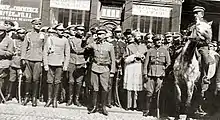Operation Minsk
Operation Mińsk was a military offensive of the Polish Army resulting in the recapture of Minsk from the Bolsheviks around August 8, 1919. The victory allowed the Polish troops to advance further into the Russian-controlled Lithuania and Belarus, and thus present the Bolsheviks with a fait accompli by driving them out of the newly acquired territories. The main Polish attack was in the direction of Maladzechna, Minsk, and Polatsk along the railroad lines. On August 6 the Polish Army took over Slutsk, and Minsk two days later. The Polish control over the railway lines, prevented the Russians from bringing in reinforcements. By the end of August, the forces of Józef Piłsudski took over Barysau and Babruisk, and forced Lenin to return to the negotiating table.[1] Operation Mińsk was considered critical for the confirmation of Polish presence in the Kresy macroregion at the time of the reconstitution of sovereign Poland (after the century of Partitions). The negotiations however, failed, which led to the Soviet invasion of ethnic Poland in July 1920.[2][3]
| Operation Minsk | |||||||
|---|---|---|---|---|---|---|---|
| Part of Polish-Soviet War | |||||||
 Polish-Soviet War & Lithuanian-Soviet War of 1919: map showing Polish & Lithuanian counterattacks. | |||||||
| |||||||
| Belligerents | |||||||
|
|
| ||||||
| Commanders and leaders | |||||||
|
|
| ||||||
| Strength | |||||||
|
14,000 men 40 guns | Unknown | ||||||
| Casualties and losses | |||||||
| Unknown | Unknown, but heavy | ||||||
History

In early 1919 on the Eastern front the Directorate of Ukraine collapsed, and by spring, the Ukrainian insurrection had failed under attack from all sides, including by the White armies. In the summer of 1919 after the Polish successes in several skirmishes with the Bolsheviks, the two combatants (both engaged on multiple fronts) have been near the limits of their capability to wage war against each other; they needed time to regroup and concentrate their forces.[2]
In June 1919,[4][5] the Jewish First Guard Battalion from Minsk – at the insistence of its own members – was deployed by the Bolsheviks against the Polish Army which included the First and the Second Lithuanian–Belarusian Divisions.[6] The Jews had won the first skirmish, forcing the Poles to retreat several kilometers.[4]
In July, the Polish High Command decided to strike one more blow against the Bolsheviks,[7] and cripple the Western Army (Russia) Western Division, headquartered in Minsk. The assault on the vital railway center by the 'Northern Group' was led by General Stanisław Szeptycki whose officers included Władysław Anders, Jozef Lasocki and Stefan Mokrzecki. Their forces were composed of 12,000 infantry, 2,000 cavalry and 40 guns. Polish plan involved a wide pincer movement around the city of Minsk. The battle raged throughout the first week of August. The Soviet forces took heavy casualties and retreated. On 8 August 1919, the Polish troops took over Minsk.[2][8] Perhaps as retribution against the Jewish regiments, they killed 31 Jews suspected of supporting the Bolshevist movement, beat and attacked many more, looted 377 Jewish-owned shops (aided by the local civilians) and ransacked many private homes.[9][10]

The success of the Polish offensive allowed the Poles to move forward again, and by the end of August Józef Piłsudski ordered his armies to stop, as he considered all territories important to Poland - and feasible to take before winter - secured.
References
- Inline
- Palij, Michael (1995). "The Genesis of the Polish-Soviet Russian War". The Ukrainian-Polish Defensive Alliance, 1919-1921: An Aspect of the Ukrainian Revolution. CIUS Press. pp. 83–84. ISBN 1895571057.
- Davies, Norman (2006) [1998]. White Eagle, Red Star (Polish edition): Biały Orzeł, Czerwona Gwiazda. Translated by Andrzej Pawelec. Kraków: Społeczny Instytut Wydawniczy Znak, 1st ed. pp. 31–32 in PDF. ISBN 83-240-0749-0. First published in 1972 as White Eagle, Red Star (doctoral theses).
—— English ed. (2011) Random House, ISBN 1446466868, pp. 59, 70. Google Books. - Snyder, Timothy (2007). Sketches from a Secret War: A Polish Artist's Mission to Liberate Soviet Ukraine. Yale University Press. p. 247. ISBN 978-0300125993.
- Budnitskii, Oleg (2012). Russian Jews Between the Reds and the Whites, 1917-1920. University of Pennsylvania Press. pp. 373, 364. ISBN 978-0812208146.
The battalion 'forced the Poles to retreat several versts' [one verst is roughly equal to 1 kilometer].
- Stachura, Peter D. (2004). Poland, 1918-1945: An Interpretive and Documentary History of the Second Republic. Psychology Press. p. 85. ISBN 0415343585.
- Gdański, Jarosław (2017). "Cossacks, Russians, and Ukrainians on the Polish side in the War of the 1920" [Kozacy, Rosjanie i Ukraińcy po stronie polskiej w wojnie 1920 r.]. Magazyn IOH (Bimonthly). Toruń: Inne Oblicza Historii. ISSN 1734-9060. Also in: Tarczyński, Marek (1998). "1 dywizja Litewsko-Białoruska (1st Lithuanian–Belarusian Division)". Battle of the Niemen; August 29 - October 18, 1920 [Bitwa niemeńska 29 VIII - 18 X 1920]. Collection of documents. Warsaw: Rytm. pp. 265, 345, 390, 647. ISBN 83-87893-55-2.
- Stachura, Peter D. (2004). Poland, 1918-1945: An Interpretive and Documentary History of the Second Republic. Psychology Press. p. 31. ISBN 0415343585 – via Google Books, preview.
- Morgenthau, Henry (1922). All in a Life-time. Doubleday & Page. p. 414. OCLC 25930642.
Minsk Bolsheviks.
- Morgenthau, Henry (1922). All in a Life-time. Doubleday & Page. p. 414. OCLC 25930642.
Minsk Bolsheviks.
- Sloin, Andrew (2017). The Jewish Revolution in Belorussia: Economy, Race, and Bolshevik Power. Indiana University Press. ISBN 9780253024633..
- General
- Davies, Norman, White Eagle, Red Star: the Polish-Soviet War, 1919–20, Pimlico, 2003, ISBN 0-7126-0694-7. (First edition: New York, St. Martin's Press, inc., 1972.), pages 58–60